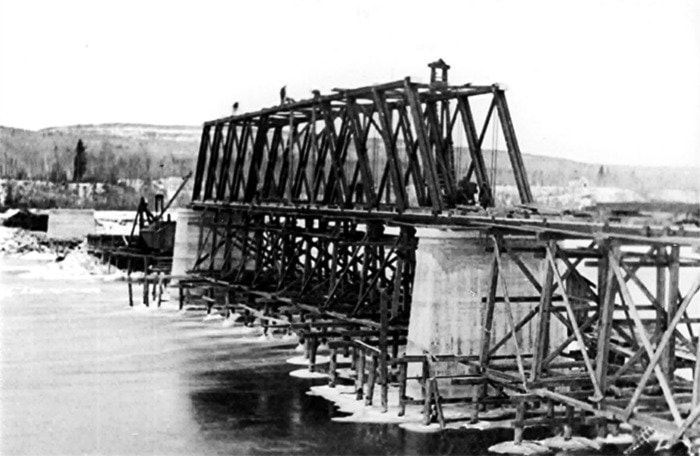HORSES MUST NOT EXCEED WALKING PACE. This sign, an artifact saved from the Fraser River Bridge, is on display in the museum. It was placed on the bridge, built in 1928-29 because it was felt that galloping horses could cause vibrations which would weaken the structure. The bridge was built using the Howe Truss system which, uses surface tension and compression, rather than bolts, to hold the structure together.
The concern about vibrations weakening the structure was apparently unfounded, as over the years cattle drives, logging trucks, heavy machinery and passenger vehicles crossed the bridge without any damage being done. Imagine the bumps and jolts as cowboys on horses, whooping and hollering, crowded herds of cattle onto the bridge and across, bursting onto Front Street and on towards the stockyards. Consider, too, the increase in heavy truck traffic, especially in the years after World War Two, when the logging industry expanded.
As one chap reported, “There were lots of little sawmills, I don’t know, a couple of hundred sawmills in the outlying district so everybody and his dog had a two and a half ton truck or three ton truck that they hauled 3 – 4,000 board feet of lumber to the planer mill. So there was quite a bit of truck traffic like that.”
With the increase in both truck traffic and passenger vehicles, congestion on the bridge became a problem. Tom Moffat recalls, “When they started moving logs by truck in Quesnel, just after the war, two trucks would meet on there and they’re only supposed to be eight feet wide, but their stakes were always leaning way out and most of them were 10-feet wide, at least, eh. And then they couldn’t pass. So, they’d meet halfway across. Sometimes there would be a fist fight over who’s going to back up.”
The solution was to install traffic lights at each end of the bridge. The traffic lights, the first ones in Quesnel, began operating in December 1953, initially from the hours of 7 a.m. to 10 p.m.
Although the lights were a big improvement, people began to see the need for a new bridge to replace what they called a horse and buggy bridge. Many groups worked hard to get the government to commit to building a new bridge. William Speare, local M.L.A., summed up the situation in an eloquent speech in his reply to the throne speech in January, 1966. He outlined the history of the bridge and its importance as a link to the west side, with its logging and other industries. In June of that year the construction of a new bridge was approved and the Moffat Bridge opened for traffic in October of 1970. The Fraser River Bridge became the footbridge as we know it today.
